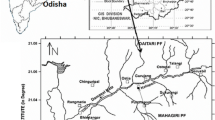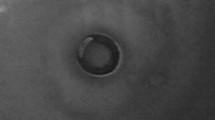Abstract
Heavy metal contamination is one of the major environmental issues around the globe and hence, this work aims to apply microbes to remove these toxic inorganic pollutants. Bacillus cereus KTSMBNL 81 isolated from electroplating industry waste-contaminated soil has been identified by biochemical and 16S rRNA sequencing analysis. B. cereus has been applied for the uptake of Cu(II) ions from the aqueous solution and the effects of various physicochemical parameters influencing Cu(II) biosorption namely, initial Cu(II) ion concentration (100–400 mg L−1), pH of the solution (2–10), temperature (25–45 °C), and contact time (0–26 h), were investigated. Maximum Cu(II) removal (89%) was observed at the following conditions: initial pH 6.0, temperature 35 °C, contact time 26 h, and initial Cu(II) concentration of 100 mg L−1. FTIR spectrum of the biomass indicated the presence of carboxyl, hydroxyl, and amino groups that might be responsible for biosorption of Cu(II) and the SEM-EDX results showed a distinct change in the surface morphology after the biosorption of Cu(II) ions. XRD pattern confirmed the crystalline nature of the organism. The results demonstrated that the B. cereus KTSMBNL 81 is very effective, tolerant, economical, and environment-friendly sorbent for removing Cu(II) ions from aqueous solutions.



Similar content being viewed by others
References
Akar, T., & Tunali, S. (2006). Biosorption characteristics of Aspergillus flavus biomass for removal of Pb(II) and Cu(II) ions from an aqueous solution. Bioresource Technology, 97(15), 1780–1787.
Alkan, M., Kalay, B., Doğan, M., & Demirbaş, Ö. (2008). Removal of copper ions from aqueous solutions by kaolinite and batch design. Journal of Hazardous Materials, 153(1–2), 867–876.
Andreazza, R., Pieniz, S., Wolf, L., Lee, M.-K., Camargo, F. A. O., & Okeke, B. C. (2010). Characterization of copper bioreduction and biosorption by a highly copper resistant bacterium isolated from copper-contaminated vineyard soil. Science of the Total Environment, 408(7), 1501–1507.
Arivalagan, P., Singaraj, D., Haridass, V., & Kaliannan, T. (2014). Removal of cadmium from aqueous solution by batch studies using Bacillus cereus. Ecological Engineering, 71, 728–735.
Aydın, H., Bulut, Y., & Yerlikaya, Ç. (2008). Removal of copper (II) from aqueous solution by adsorption onto low-cost adsorbents. Journal of Environmental Management, 87(1), 37–45.
Bajpai, A. K., & Vishwakarma, N. (2003). Adsorption of polyvinylalcohol onto Fuller’s earth surfaces. Colloids and Surfaces A: Physicochemical and Engineering Aspects, 220(1–3), 117–130.
Benaïssa, H., & Elouchdi, M. A. (2011). Biosorption of copper (II) ions from synthetic aqueous solutions by drying bed activated sludge. Journal of Hazardous Materials, 194, 69–78.
Blázquez, G., Martín-Lara, M. A., Dionisio-Ruiz, E., Tenorio, G., & Calero, M. (2012). Copper biosorption by pine cone shell and thermal decomposition study of the exhausted biosorbent. Journal of Industrial and Engineering Chemistry, 18(5), 1741–1750.
Congeevaram, S., Dhanarani, S., Park, J., Dexilin, M., & Thamaraiselvi, K. (2007). Biosorption of chromium and nickel by heavy metal resistant fungal and bacterial isolates. Journal of Hazardous Materials, 146(1–2), 270–277.
Dhanarani, S., Viswanathan, E., Piruthiviraj, P., Arivalagan, P., & Kaliannan, T. (2016). Comparative study on the biosorption of aluminum by free and immobilized cells of Bacillus safensis KTSMBNL 26 isolated from explosive contaminated soil. Journal of the Taiwan Institute of Chemical Engineers, 69, 61–67.
Ghosh, A., & Saha, P. D. (2013). Optimization of copper bioremediation by Stenotrophomonas maltophilia PD2. Journal of Environmental Chemical Engineering, 1(3), 159–163.
Karthik, C., Barathi, S., Pugazhendhi, A., Ramkumar, V. S., Thi, N. B. D., & Arulselvi, P. I. (2017). Evaluation of Cr(VI) reduction mechanism and removal by Cellulosimicrobium funkei strain AR8, a novel haloalkaliphilic bacterium. Journal of Hazardous Materials, 333, 42–53.
Khormaei, M., Nasernejad, B., Edrisi, M., & Eslamzadeh, T. (2007). Copper biosorption from aqueous solutions by sour orange residue. Journal of Hazardous Materials, 149(2), 269–274.
Kulkarni, R. M., Shetty, K. V., & Srinikethan, G. (2014). Cadmium (II) and nickel (II) biosorption by Bacillus laterosporus (MTCC 1628). Journal of the Taiwan Institute of Chemical Engineers, 45(4), 1628–1635.
Masood, F., & Malik, A. (2011). Biosorption of metal ions from aqueous solution and tannery effluent by Bacillus sp. FM1. Journal of Environmental Science and Health, 46(14), 1667–1674.
Maurya, N. S., Mittal, A. K., Cornel, P., & Rother, E. (2006). Biosorption of dyes using dead macro fungi: effect of dye structure, ionic strength and pH. Bioresource Technology, 97(3), 512–521.
Naik, U. C., Srivastava, S., & Thakur, I. S. (2012). Isolation and characterization of Bacillus cereus IST105 from electroplating effluent for detoxification of hexavalent chromium. Environmental Science and Pollution Research, 19(7), 3005–3014.
Naz, T., Khan, M. D., Ahmed, I., Rehman, S. U., Rha, E. S., Malook, I., & Jamil, M. (2016). Biosorption of heavy metals by Pseudomonas species isolated from sugar industry. Toxicology and Industrial Health, 32(9), 1619–1627.
Nazari, A. M., Cox, P. W., & Waters, K. E. (2014). Biosorption of copper, nickel and cobalt ions from dilute solutions using BSA-coated air bubbles. Journal of Water Process Engineering, 3, 10–17.
Oves, M., Khan, M. S., & Zaidi, A. (2013). Biosorption of heavy metals by Bacillus thuringiensis strain OSM29 originating from industrial effluent contaminated north Indian soil. Saudi Journal of Biological Sciences, 20(2), 121–129.
Peng, Q., Liu, Y., Zeng, G., Xu, W., Yang, C., & Zhang, J. (2010). Biosorption of copper(II) by immobilizing Saccharomyces cerevisiae on the surface of chitosan-coated magnetic nanoparticles from aqueous solution. Journal of Hazardous Materials, 177(1–3), 676–682.
Puyen, Z. M., Villagrasa, E., Maldonado, J., Diestra, E., Esteve, I., & Solé, A. (2012). Biosorption of lead and copper by heavy-metal tolerant Micrococcus luteus DE2008. Bioresource Technology, 126, 233–237.
Reddad, Z., Gérente, C., Andrès, Y., Ralet, M.-C., Thibault, J.-F., & Cloirec, P. L. (2002). Ni(II) and Cu(II) binding properties of native and modified sugar beet pulp. Carbohydrate Polymers, 49(1), 23–31.
Saleem, M., Pirzada, T., & Qadeer, R. (2007). Sorption of acid violet 17 and direct red 80 dyes on cotton fiber from aqueous solutions. Colloids and Surfaces A: Physicochemical and Engineering Aspects, 292(2–3), 246–250.
Sarı, A., & Tuzen, M. (2008). Biosorption of cadmium(II) from aqueous solution by red algae (Ceramium virgatum): equilibrium, kinetic and thermodynamic studies. Journal of Hazardous Materials, 157(2–3), 448–454.
Sulaymon, A. H., Mohammed, A. A., & Al-Musawi, T. J. (2013). Competitive biosorption of lead, cadmium, copper, and arsenic ions using algae. Environmental Science and Pollution Research International, 20(5), 3011–3023.
USEPA (U.S. Environmental Protection Agency), (2014). USEPA Integrated Risk Information System (IRIS) online database. Available at: http://www.epa.gov/iris. Accessed Nov 2015.
Velásquez, L., & Dussan, J. (2009). Biosorption and bioaccumulation of heavy metals on dead and living biomass of Bacillus sphaericus. Journal of Hazardous Materials, 167(1–3), 713–716.
Wang, S., Boyjoo, Y., Choueib, A., & Zhu, Z. H. (2005). Removal of dyes from aqueous solution using fly ash and red mud. Water Research, 39(1), 129–138.
Wang, J., & Chen, C. (2009). Biosorbents for heavy metals removal and their future. Biotechnology Advances, 27(2), 195–226.
Wang, X.-H., Song, R.-H., Teng, S.-X., Gao, M.-M., Ni, J.-Y., Liu, F.-F., et al. (2010). Characteristics and mechanisms of Cu(II) biosorption by disintegrated aerobic granules. Journal of Hazardous Materials, 179(1–3), 431–437.
Weng, C.-H., Lin, Y.-T., Hong, D.-Y., Sharma, Y. C., Chen, S.-C., & Tripathi, K. (2014). Effective removal of copper ions from aqueous solution using base treated black tea waste. Ecological Engineering, 67, 127–133.
WHO. (2008) http://www.who.int/water_sanitation_health/dwq/fulltext.pdf
Wu, Q., Cui, Y., Li, Q., & Sun, J. (2015). Effective removal of heavy metals from industrial sludge with the aid of a biodegradable chelating ligand GLDA. Journal of Hazardous Materials, 283, 748–754.
Xiao-jing, H., Hai-dong, G., Ting-ting, Z., Yu, J., & Juan-juan, Q. (2014). Biosorption mechanism of Cu2+ by innovative immobilized spent substrate of fragrant mushroom biomass. Ecological Engineering, 73, 509–513.
Yargıç, A. Ş., Yarbay Şahin, R. Z., Özbay, N., & Önal, E. (2015). Assessment of toxic copper(II) biosorption from aqueous solution by chemically-treated tomato waste. Journal of Cleaner Production, 88, 152–159.
Zhou, W., Wang, J., Shen, B., Hou, W., & Zhang, Y. (2009). Biosorption of copper(II) and cadmium(II) by a novel exopolysaccharide secreted from deep-sea mesophilic bacterium. Colloids and Surfaces B: Biointerfaces, 72(2), 295–302.
Acknowledgements
The authors gratefully acknowledge DST-FIST (FST: SR/FST/LSI-687/2016) for providing the AAS instrumentation facility and UGC for providing SAP (UGC-SAP:No.F.5-4/2016/DRS-I(SAP-11)) to the Department of Environmental Biotechnology, Bharathidasan University, Tiruchirappalli, Tamil Nadu, India.
Author information
Authors and Affiliations
Corresponding author
Rights and permissions
About this article
Cite this article
Pugazhendhi, A., Ranganathan, K. & Kaliannan, T. Biosorptive Removal of Copper(II) by Bacillus cereus Isolated from Contaminated Soil of Electroplating Industry in India. Water Air Soil Pollut 229, 76 (2018). https://doi.org/10.1007/s11270-018-3734-0
Received:
Accepted:
Published:
DOI: https://doi.org/10.1007/s11270-018-3734-0




